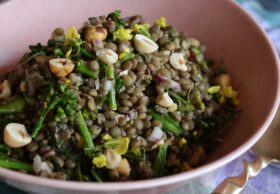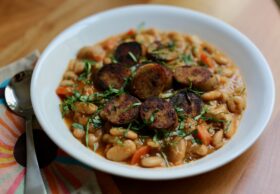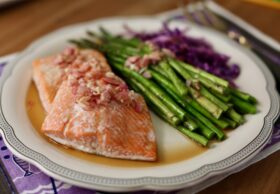Fermented Pickles
I’ve been sitting on this recipe since last fall when I finally figured out fermented pickles. It’s been VERY HARD keeping it to myself all this time so when I saw pickling cucumbers at the farmers market again this past weekend, I got VERY EXCITED.
This easy fermented pickle method uses salt water but also a secret little trick I call raw apple cider vinegar. Maybe it’s not so secret but it’s a great trick, especially if you’re new to fermenting and a little skeered.
Why fermented pickles???
Many easy pickle recipes use a combination of white vinegar, water and salt to make cucumbers that taste like pickles. And while those are good — I love anything sour and salty — they lack the digestif properties of real, fermented pickles with all the healthy bacteria.
My method combines salt-water fermentation with a touch of raw vinegar (Bragg’s is one brand, but there are others; be sure it says raw or unpasteurized and unfiltered on the label) to get the right kind of bacteria started. It’s perfect for people who are new to home fermentation and maybe a little nervous about colonizing the wrong kind of bacteria or heaven forbid, mold. (Mold is what I got the first time I tried making my own sauerkraut and I will tell you nothing stinks up a kitchen like forgotten, moldy cabbage.)
Mushy Pickles???
One common problem with homemade pickles is ending up with soft, mushy pickles with no crunch. Adding tannins to your brine helps keep pickles crunchy. Tannins can be in the form of black or green tea leaves, grape vine leaves, oak leaves or just a good ol’ fashioned bay leaf, which is what I use. I experimented with adding a teaspoon of loose-leaf tea, also, but found that the the bay leaf works just as well and adds a nice flavor, too.
If you have fresh, un-sprayed, grape or oak leaves available, you can also tuck a small one of those into each jar.
Serve your homemade pickles with a BBQ chicken sandwich, a fancy grilled cheese or a kalua pork sandwich.
For more fermentation, try making your own kimchi!
PrintFermented Pickles
Ingredients
12 ounces small pickling cucumbers (around 2 inches long)
several sprigs fresh dill
2 cloves garlic, smashed and peeled
1 teaspoon black peppercorns
1 large bay leaf
1/2 teaspoon whole coriander seed
2 cups hot water (filtered if possible)
1 tablespoon sea salt
1 tablespoon unfiltered apple cider vinegar
Instructions
Wash the cucumbers. I fill a bowl up with warm tap water and a little salt and swish them around in that. Drain and rinse again.
Put into a quart jar: 1 garlic clove, dill, half the peppercorns and half the coriander. Pack the pickles into the jar. They should just reach the neck of the jar. Add the other garlic and remaining spices.
Dissolve salt in the hot water and then add vinegar. Pour into jar. It should cover the pickles by at least an inch. Seal loosely with a ring and cap, or tie some cheesecloth over the top. Place jar on a small plate to catch drips and put it in a dark spot for a few days.
Once some bubbles have started to form around the top of the brine, you can taste the pickles and see how you like them. For more sour pickles, let them sit longer. If you like them, cover the jar and refrigerate. Eat within a couple of weeks for best texture.
18 Comments
Leave a Comment











Such a wonderful recipe as well as your instructions and information! Thank you!
Made these pickles and they taste great. We had no bubbling and a little bit of scum thst we removed. The problem is that the liquid is very cloudy. Yours is so clear. Is it safe to store them in this? Thanks for a great recipe. I’m looking forward to hearing from you.
Could it be that you used salt that is not “canning salt?” Regular salt will cloud your brine. If you already know, ignore this, but here is an article explaining. 🙂 https://www.thekitchn.com/what-is-pickling-salt-do-you-really-need-it-193108
I made these also, they were clear at first. Then they became cloudy. That is a good thing.
I’ve been trying to make these pickles forever, they never seem to turn out like my favorite brand Bubbies pickles. I get my pickles from grocery store,, wondering if that is the issue. What does the addition of raw apple cider vinegar do? Do I need to add it? Thanks! -Ron
Hey Ron,
It’s important to use “pickling cucumbers” not the large, shiny, waxed salad cucumbers. Pickling cukes are smaller, lumpier, and have a dull, unwaxed skin. You can sometimes find them in regular stores, more likely at farmers markets, though.
The AC vinegar helps kickstart the fermentation. You don’t need to add it, but the pickles will take longer to ferment.
To me, Bubbies are pretty strong pickles, so maybe you should just let yours ferment longer on the counter. The cloudy brine of Bubbies is indicative of lots of bacterial and yeast activity so you could watch your brine and let that be your guide.
Good luck!
Thanks, Hilah!
Yes, I am aware of the pickling variety and that is what I’ve been using. Where did you learn the Raw apple cider vinegar trick? I’ve heard of using whey or rye bread but never raw vinegar, I’ll have to give it a try, maybe that is the tip I needed 🙂
Regards,
Ron
Lil Hilah all grown up. Hey it’s Mac from back in the day and you came up in the top listings on my Google search for this! You go girl! I’m cooking professional like in Burlington, Vermont these days. My girl and I have an amazing garden. Can’t wait to try this recipe out. Need to get the right vinegar or maybe I will try to ferment with some leftover brine I had from simple refrigerator pickles. Good to find you again.
Hey Mac! Good to hear from you 🙂
this makes fantastic pickles, vinegar typically hurts my stomach but lacto fermented pickles dont hurt in the slightest and now I can eat all the pickles I want again, Ive tried this recipe with carrots and green beans as well and they are FANTASTIC. Thanks for all the info, I did cut out the vinegar and let mine go in my pickling crock for about 10 days and they are perfectly garlicky, dilly and sour! my wife is a huge pickle head and she says these are the best she has ever had 🙂 going to be doing sauerkraut and onions for me next batch. Also I had surgery 15 years ago to remove my large intestine at age 30 and have had digestion issues ever since but with the introduction of lacto fermented veggies and pickles my gastro system is SOOOOOO much better! Thanks again!!!
What a great success story, Chad! Thanks for sharing and thanks for the tips on pickling 🙂
Hi for the hot and dry Central Texas! I was wondering if you can can after fermenting? Don’t have a lot of refrigerator storage. And also, the person who said she was doing green beans and carrots. I have never had a pickled bean or carrot. Do you use same recipe just with those vegetables? Thanks so much~Megan
Hey Megan! I haven’t tried to can these. But for other veg, yes you just would trip the beans or cut the carrots into sticks and follow the same recipe. Pickled carrots and beans are great in salads or bloody Marys!
I always use a 3.5% salt water brine. The weather is getting warmer, so should I raise or lower the salt percentage?
Will try this recipe along with others I have accumulated. Just need to get some Apple CIder Vinegar.
Just found your website and already I have two recipes to try. Well, actually I’ve made fermented pickles; have a fresh jar in my fridge now. But I like your instructions and want to try your version. I wasn’t sure about the cider vinegar as I wanted authentic pickles and using vinegar just seems like an unnecessary shortcut. But I am a fan of raw unfiltered apple cider vinegar, and your theory makes sense so I’ll give it a try.
Hi Hilah. I am new to fermenting, so I started with your pickle recipe. The flavor is great, but the skins were tough/chewy and the centers were mush. I used Kirby cucumbers, soaked them in ice water for an hour, quartered them to have spears, and followed your recipe. i let them ferment for 5 days and there was visible bubbling. At the end the brine was cloudy, but I read that was ok for fermented pickles. What did I do wrong? I want to try again.
Hi, tried the recipe and other than using a bigger jar, I think I did everything as instructed. But there is no flavor in the pickles and when I taste the water, it also doesn’t have a strong taste. It’s been sitting for 3 days, what did I do wrong?